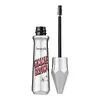What's inside
What's inside
 Key Ingredients
Key Ingredients

No key ingredients
 Benefits
Benefits

 Concerns
Concerns

 Ingredients Side-by-side
Ingredients Side-by-side

Water
Skin ConditioningMica
Cosmetic ColorantGlyceryl Stearate
EmollientPentylene Glycol
Skin ConditioningCellulose
AbsorbentMagnesium Aluminum Silicate
AbsorbentPEG-100 Stearate
Phenoxyethanol
PreservativePolyacrylamide
C13-14 Isoparaffin
EmollientSodium Stearate
CleansingCetearyl Alcohol
EmollientLaureth-7
EmulsifyingPanthenol
Skin ConditioningGlycerin
HumectantCeteareth-20
CleansingCalcium Chloride
AstringentAlthaea Officinalis Root Extract
Skin ConditioningCitric Acid
BufferingPotassium Sorbate
PreservativeSodium Benzoate
MaskingCI 77491
Cosmetic ColorantCI 77492
Cosmetic ColorantCI 77499
Cosmetic ColorantCI 77891
Cosmetic ColorantWater, Mica, Glyceryl Stearate, Pentylene Glycol, Cellulose, Magnesium Aluminum Silicate, PEG-100 Stearate, Phenoxyethanol, Polyacrylamide, C13-14 Isoparaffin, Sodium Stearate, Cetearyl Alcohol, Laureth-7, Panthenol, Glycerin, Ceteareth-20, Calcium Chloride, Althaea Officinalis Root Extract, Citric Acid, Potassium Sorbate, Sodium Benzoate, CI 77491, CI 77492, CI 77499, CI 77891
Water
Skin ConditioningBeeswax
Emulsion StabilisingButylene Glycol
HumectantCopernicia Cerifera Wax
Propylene Glycol Stearate
Skin ConditioningGlyceryl Stearate
EmollientStearic Acid
CleansingIsostearic Acid
CleansingPvp
Emulsion StabilisingDimethicone
EmollientTromethamine
BufferingMica
Cosmetic ColorantOleic Acid
EmollientSilica
AbrasivePolybutene
Lecithin
EmollientCellulose Gum
Emulsion StabilisingXanthan Gum
EmulsifyingGlyceryl Laurate
EmollientSorbitan Laurate
EmulsifyingSoluble Collagen
HumectantIsopropyl Titanium Triisostearate
EmollientPropylene Glycol Laurate
Skin ConditioningPolymethyl Methacrylate
Magnesium Aluminum Silicate
AbsorbentPolysorbate 20
EmulsifyingSodium Hyaluronate
HumectantSodium Dehydroacetate
PreservativeCaprylyl Glycol
EmollientHexylene Glycol
EmulsifyingPhenoxyethanol
PreservativeDisodium EDTA
CI 77891
Cosmetic ColorantIron Oxides
CI 77510
Cosmetic ColorantWater, Beeswax, Butylene Glycol, Copernicia Cerifera Wax, Propylene Glycol Stearate, Glyceryl Stearate, Stearic Acid, Isostearic Acid, Pvp, Dimethicone, Tromethamine, Mica, Oleic Acid, Silica, Polybutene, Lecithin, Cellulose Gum, Xanthan Gum, Glyceryl Laurate, Sorbitan Laurate, Soluble Collagen, Isopropyl Titanium Triisostearate, Propylene Glycol Laurate, Polymethyl Methacrylate, Magnesium Aluminum Silicate, Polysorbate 20, Sodium Hyaluronate, Sodium Dehydroacetate, Caprylyl Glycol, Hexylene Glycol, Phenoxyethanol, Disodium EDTA, CI 77891, Iron Oxides, CI 77510
 Reviews
Reviews

Ingredients Explained
These ingredients are found in both products.
Ingredients higher up in an ingredient list are typically present in a larger amount.
Ci 77891 is a white pigment from Titanium dioxide. It is naturally found in minerals such as rutile and ilmenite.
It's main function is to add a white color to cosmetics. It can also be mixed with other colors to create different shades.
Ci 77891 is commonly found in sunscreens due to its ability to block UV rays.
Learn more about CI 77891Glyceryl Stearate is a mix of glycerin and stearic acid.
It is used to stabilize the mixing of water and oil ingredients. By preventing these ingredients from separating, it can help elongate shelf life. It can also help thicken the product's texture.
As an emollient, it helps soften skin and supports barrier-replenishing ingredients.
In cosmetics, Glyceryl Stearate is often made from vegetable oils or synthetically produced.
This ingredient may not be fungal-acne safe
Fun fact: The human body also creates Glyceryl Stearate naturally.
Learn more about Glyceryl StearateMagnesium Aluminum Silicate is a type of silica. It comes from naturally occuring minerals such as silicate ores and clay.
Magnesium aluminum silicate is used for enhancing texture and as an absorbent. Due to its large molecular size, it is unable to be absorbed into the skin.
Like other types of silica, this ingredient can be used to thicken a product. As an absorbent, it may be used to absorb extra water or help prevent clumping.
Although “aluminum” in an ingredient name can raise red flags for some consumers, the form and usage context matter significantly. For typical topical applications, there is no substantial evidence of health risks - such as cancer, neurotoxicity, or systemic “aluminum overload.”
Learn more about Magnesium Aluminum SilicateMica is a naturally occurring mineral used to add shimmer and color in cosmetics. It can also help improve the texture of a product or give it an opaque, white/silver color.
Serecite is the name for very fine but ragged grains of mica.
This ingredient is often coated with metal oxides like titanium dioxide. Trace amounts of heavy metals may be found in mica, but these metals are not harmful in our personal products.
Mica has been used since prehistoric times throughout the world. Ancient Egyptian, Indian, Greek, Roman, Aztec, and Chinese civilizations have used mica.
Learn more about MicaPhenoxyethanol is a preservative that has germicide, antimicrobial, and aromatic properties. Studies show that phenoxyethanol can prevent microbial growth. By itself, it has a scent that is similar to that of a rose.
It's often used in formulations along with Caprylyl Glycol to preserve the shelf life of products.
Water. It's the most common cosmetic ingredient of all. You'll usually see it at the top of ingredient lists, meaning that it makes up the largest part of the product.
So why is it so popular? Water most often acts as a solvent - this means that it helps dissolve other ingredients into the formulation.
You'll also recognize water as that liquid we all need to stay alive. If you see this, drink a glass of water. Stay hydrated!
Learn more about Water